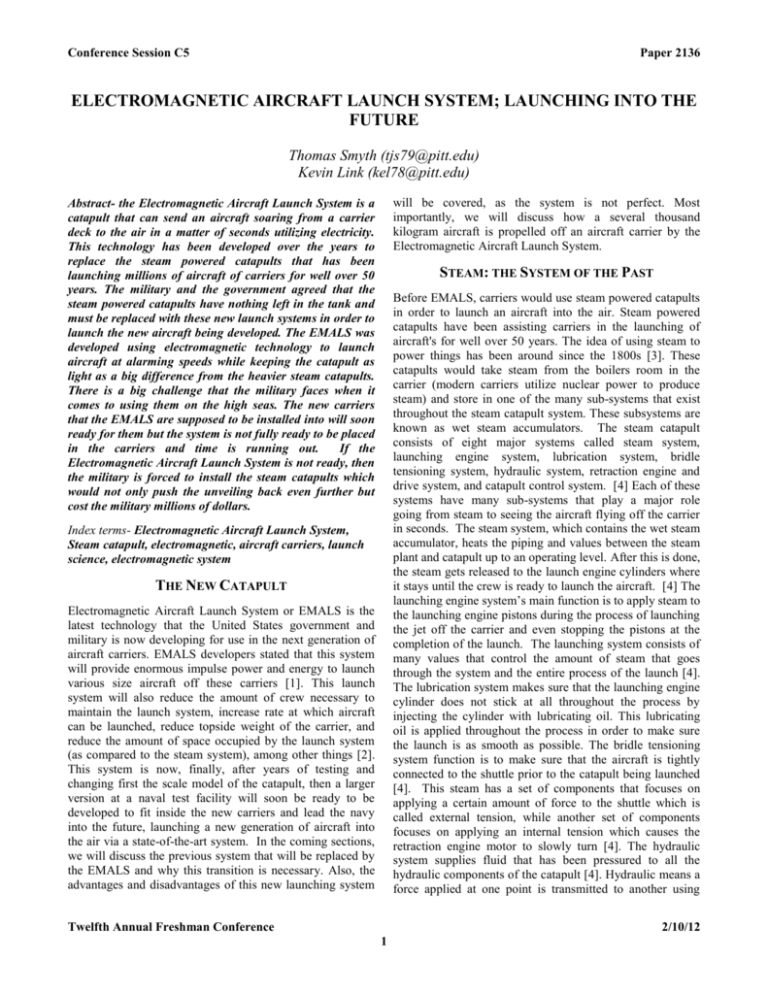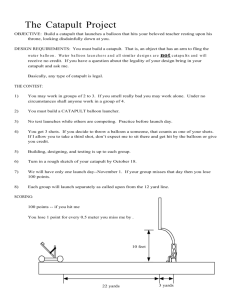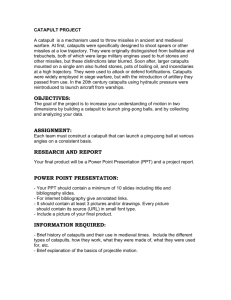terms- Electromagnetic Aircraft Launch System, Steam catapult
advertisement

Conference Session C5 Paper 2136 ELECTROMAGNETIC AIRCRAFT LAUNCH SYSTEM; LAUNCHING INTO THE FUTURE Thomas Smyth (tjs79@pitt.edu) Kevin Link (kel78@pitt.edu) will be covered, as the system is not perfect. Most importantly, we will discuss how a several thousand kilogram aircraft is propelled off an aircraft carrier by the Electromagnetic Aircraft Launch System. Abstract- the Electromagnetic Aircraft Launch System is a catapult that can send an aircraft soaring from a carrier deck to the air in a matter of seconds utilizing electricity. This technology has been developed over the years to replace the steam powered catapults that has been launching millions of aircraft of carriers for well over 50 years. The military and the government agreed that the steam powered catapults have nothing left in the tank and must be replaced with these new launch systems in order to launch the new aircraft being developed. The EMALS was developed using electromagnetic technology to launch aircraft at alarming speeds while keeping the catapult as light as a big difference from the heavier steam catapults. There is a big challenge that the military faces when it comes to using them on the high seas. The new carriers that the EMALS are supposed to be installed into will soon ready for them but the system is not fully ready to be placed in the carriers and time is running out. If the Electromagnetic Aircraft Launch System is not ready, then the military is forced to install the steam catapults which would not only push the unveiling back even further but cost the military millions of dollars. STEAM: THE SYSTEM OF THE PAST Before EMALS, carriers would use steam powered catapults in order to launch an aircraft into the air. Steam powered catapults have been assisting carriers in the launching of aircraft's for well over 50 years. The idea of using steam to power things has been around since the 1800s [3]. These catapults would take steam from the boilers room in the carrier (modern carriers utilize nuclear power to produce steam) and store in one of the many sub-systems that exist throughout the steam catapult system. These subsystems are known as wet steam accumulators. The steam catapult consists of eight major systems called steam system, launching engine system, lubrication system, bridle tensioning system, hydraulic system, retraction engine and drive system, and catapult control system. [4] Each of these systems have many sub-systems that play a major role going from steam to seeing the aircraft flying off the carrier in seconds. The steam system, which contains the wet steam accumulator, heats the piping and values between the steam plant and catapult up to an operating level. After this is done, the steam gets released to the launch engine cylinders where it stays until the crew is ready to launch the aircraft. [4] The launching engine system’s main function is to apply steam to the launching engine pistons during the process of launching the jet off the carrier and even stopping the pistons at the completion of the launch. The launching system consists of many values that control the amount of steam that goes through the system and the entire process of the launch [4]. The lubrication system makes sure that the launching engine cylinder does not stick at all throughout the process by injecting the cylinder with lubricating oil. This lubricating oil is applied throughout the process in order to make sure the launch is as smooth as possible. The bridle tensioning system function is to make sure that the aircraft is tightly connected to the shuttle prior to the catapult being launched [4]. This steam has a set of components that focuses on applying a certain amount of force to the shuttle which is called external tension, while another set of components focuses on applying an internal tension which causes the retraction engine motor to slowly turn [4]. The hydraulic system supplies fluid that has been pressured to all the hydraulic components of the catapult [4]. Hydraulic means a force applied at one point is transmitted to another using Index terms- Electromagnetic Aircraft Launch System, Steam catapult, electromagnetic, aircraft carriers, launch science, electromagnetic system THE NEW CATAPULT Electromagnetic Aircraft Launch System or EMALS is the latest technology that the United States government and military is now developing for use in the next generation of aircraft carriers. EMALS developers stated that this system will provide enormous impulse power and energy to launch various size aircraft off these carriers [1]. This launch system will also reduce the amount of crew necessary to maintain the launch system, increase rate at which aircraft can be launched, reduce topside weight of the carrier, and reduce the amount of space occupied by the launch system (as compared to the steam system), among other things [2]. This system is now, finally, after years of testing and changing first the scale model of the catapult, then a larger version at a naval test facility will soon be ready to be developed to fit inside the new carriers and lead the navy into the future, launching a new generation of aircraft into the air via a state-of-the-art system. In the coming sections, we will discuss the previous system that will be replaced by the EMALS and why this transition is necessary. Also, the advantages and disadvantages of this new launching system Twelfth Annual Freshman Conference 2/10/12 1 Conference Session C5 Paper 2136 some sort of fluid. This force is usually multiplied throughout the process. The retraction engine and drive system make use of components needed to return the launching engine pistons and shuttle back to the battery position after each and every launch or to maneuver the grab. The grab is just a spring-loaded latch that is mounted on a wheel frame and basically brings the shuttle and piston back to the starting position in order to prepare the system for the next launch. The last system of the steam catapult is the catapult control system which is a series of panels, lights, and switches used by the crew on the carrier to control the catapult throughout the process. [4] Launching an aircraft off a carrier by steam catapult is a very simple process to understand but can seem complicated by all the systems in the catapult. The process all starts, as stated before, in the carrier’s boiler room where steam gathers into the steam system. Once enough steam is collected into steam system, the steam is then released to launching engine cylinders. The amount of steam needed for each launch can varied by each launch and must be control by capacity value which controls the rate of steam released into the cylinders [4]. All this steam acts on the set of steam pistons inside the launching engine cylinders that are connect to a shuttle which is latch onto the aircraft. The amount of force that the steam is coming out of the steam accumulator is what causes the aircraft to be launch off the carrier at enormous speeds [4]. This force being pushed on the pistons not only propels the piston forward but causes the shuttle and aircraft to hit those topping speeds in a few seconds until the entire takeoff is complete. Once the aircraft is launched from the carrier, the shuttle and pistons are stopped and the grab comes forward and latches itself to the shuttle so it can all be brought back to the battery, or starting position, for the next launch. Once this is brought back, the crew has to determine if the catapult is in the ready, standby, or shutdown mode. If the catapult is in the ready mode, then the crew can proceed to moving on to the next launch on schedule. While if the catapult is in the standby mode, then there cannot be any launches off it for 12 hours and it must go through a full inspection, but this only comes after a full day of operations [4]. Finally, the catapult is determined to be in shutdown whenever it has to go under maintenance or the carrier is in port [4]. There are a lot factors and safety measures that the whole crew need to account for before, during, and after every launch. For example, they need to make sure that the wind is within the right limits that have been set as well as making sure that everyone is on the same page when it comes to the details on every launch. In the next section, the discussion will be based on why the steam-powered catapult is being replaced by the Electromagnetic Aircraft Launch System and the factors that caused this change. WHY THE CHANGE? Like so many other things in today’s world, the steam powered catapult is on the verge of becoming yesterday’s news as great strides are made by developers in the past years several. The steam catapult is quickly becoming hopelessly outdated and thus the Electromagnetic Aircraft Launch System is being developed to fill the void and help to eliminate the problems that will develop if the military continues to use the steam catapult. The steam powered catapult went through the same problems that another major source of transportation that requires lots of steam. This method of transportation is the steam-powered locomotives [3]. These systems were similar in the numerous amounts of assemblies it needed in order to function properly at the all times such as valves, coils, and pipes, among others. These assemblies gave the steam catapult problems since everything needed to be under constant maintenance in order for the catapult to remain in working order. In addition, the steam catapult occupies a large amount of space on the carrier, especially below the deck. This takes ups valuable space that could be used for other means. Also, having the extremely heavy catapult system so close to the top of the carrier affects the ship's stability and ability to turn [3]. Another drawback to using a steam catapult is that once the launch begins there is no way to make adjustments to the launch, so if there is too much steam, the catapult could be destroyed. If there is very little steam, the aircraft would just tumble into the water, being unable to reach its necessary takeoff speed [5]. Since today's aircraft are getting much larger and heavier, they need a catapult or launch system that can launch these aircraft at the necessary speeds in order for them to get airborne. The EMALS is able to launch these new mightier aircraft at their desired speeds in a short amount of time and then be ready for the next launch in not minutes but seconds after the launch. This system also has the capabilities to make adjustments during the launch process [5], allowing to the aircraft to have a much longer life service, and crew members to have better control over the launch, unlike the steam catapult. Not only are there even more advantages for the new carriers to use the Electromagnetic Aircraft Launch System but there are also disadvantages that this launch system has and all this will be discuss in the next sections. ADVANTAGES The EMALS offers several advantages over the past system. The system itself is more powerful than the steam catapult, which will allow it to handle to new aircraft (as new aircraft are usually heavier than previous versions) [6]. The system also has the ability to “reset” itself more quickly than the steam version. This means the electromagnetic system can be ready to launch another aircraft after a launch more quickly than the previous system. This will allow the aircraft Twelfth Annual Freshman Conference 2/10/12 2 Conference Session C5 Paper 2136 carriers to put more aircraft into the air in a smaller amount of time. [1] Another important aspect to the EMALS is the reduced maintenance to the system and the aircraft that utilize the system. It is designed to utilize “commercial off-the-shelf components.” [2] This, along with the fact that the system is made to be modular, meaning it is easy to disassemble or remove parts of the system, makes maintenance on the system simpler and less expensive. The system is also designed to allow control of the speed of the motor as it travels down the rail, which prevents excess speed, and in turn strain, from being applied to the aircraft taking off. It also makes the system more versatile, meaning it will have the ability to launch both the heavier aircraft mentioned earlier and the new unmanned drones being developed. The future of carrier-borne aircraft will be reliant on this system, as the steam catapult lacks the ability to launch the newer aircraft being developed for the military. begin with the energy brought from the prime energy sources on board, which are the ship’s generators (the energy there is produced by the ship’s nuclear reactor). This energy then goes to the storage subsystem, which contains the energy until it is needed in order to make a launch. When it comes time to launch, the energy is distributed to the launch motor, which is also subsystem. It is during this time the on board systems have the ability to adjust the speed of the catapult. Once a launch is complete, the shuttle that carried the aircraft is returned to its original position, utilizing the same principle that launched the shuttle down the runway. These subsystems are constructed using a “modular” design, [2] meaning that the pieces that make up the system can be easily removed for maintenance or replacement. This will allow the subsystems to be easily placed into the carrier, and greatly reduce maintenance time on the subsystems. Also, it will allow engineers to easily upgrade the subsystem as the years go on. In the following sections, the most crucial subsystems and their roles in the launch process are discussed in detail. DISADVANTAGES While the necessity for change is clear, the EMALS has its challenges and disadvantages. Currently, its most pressing issue is time. The system is currently being developed with the funding from the federal government of the United States, in order to have it implemented in the new class of carriers being constructed. However, concerns have been raised [1] about whether or not the system will be ready in time to coincide with the carrier construction. If the government sees the delays as being too expensive, the funding will be cut and the carriers will be fitted with the old steam catapult system. The point of no return will be before it becomes expensive/nearly impossible to adjust the carriers in order to fit the steam catapults [1]. If the project loses the United States federal funding for any reason, it is highly unlikely the development will continue, as it is mainly being backed by, and is intertwined with the United States government and military. A more mechanical threat to the system involves the fact that you have a large amount of electrical energy being discharged near sensitive electronics. This electrical interference is a very real threat to the electrical and computer systems on board the sensitive “smart” weapons (missiles and bombs that contain computerized guidance systems) that the launch aircraft may be carrying [1]. Tests will be done to see how the pulse from this system affects each one of these weapons when carried by an aircraft during launch. Predictions have been made that there will not be an adverse effect on these systems. However, to fully understand this threat, an understanding of what occurs before, during, and after launch is necessary. The next few sections explain in detail these events. Energy Storage and Distribution In order to deliver the several thousands of volts to the motor in the two to three seconds it takes to launch the aircraft, the ship requires a system that can store and release this energy as quickly and efficiently as possible. The decision was made to use electrical flywheels to store the energy. Electrical energy from the ship’s main generators (which are run by a nuclear reactor) is delivered into the large flywheels. The flywheels then are accelerated to approximately four thousand revolutions per minute [1]. The flywheels maintain the rotational velocity, thereby storing the necessary energy for a launch. When a launch occurs, the system pulls the energy in from the flywheel generator out to be used for the launch. The kinetic energy of the flywheels is transformed into electrical energy, which is passed to the motor. Since the flywheels have lost energy, they have slowed down considerably. In order to maintain the quick reset time, the flywheels immediately begin accelerating back to the four thousand rpm mark by taking more energy from the ship’s generators [4]. Launch Motor The launch motor is the most crucial and experimental portion of the system. Its job is to accelerate aircraft that weigh tens of thousands of kilograms down an approximately one hundred and six meter runway to speeds above 200 kilometers per hour in two to three seconds [6]. Then it must return to its original position and be ready to repeat the process in less than forty-five seconds. This whole process is made possible by the huge amount of electrical energy delivered to the launch motor. The energy is delivered to a system that is known as a THE SYSTEM The electromagnetic aircraft launch system can be broken down into a number of subsystems [2]. These subsystems Twelfth Annual Freshman Conference 2/10/12 3 Conference Session C5 Paper 2136 “linear motor.” Because of the large acceleration of a large mass, a linear motor is similar to the workings of experimental rail guns, which accelerate small projectiles to enormous velocities. The linear motor system is so named because instead of creating rotational motion like common motors, it creates linear motion along its length. This motion occurs because of “stators” that run the length of the runway. There are two parallel rows of these stators side-by-side. In between them is the mechanism that attaches to the aircraft. This consists of a piece of aluminum and the “shuttle” that attaches to the aircraft. When a launch occurs, the energy from the generators is delivered to the stators on either side of the shuttle at the beginning of the runway [1]. The electric current creates a strong magnetic field, which in turn creates and electric and magnetic field in the aluminum in between the stators. This secures the shuttle inside a magnetic field. However, the electrical energy is then passed to the stators further and further down the runway. A magnetic “wave” occurs, as each subsequent stator is charged by the electrical energy. The wave carries the aluminum block and shuttle down the runway, along with the aircraft that is attached to the shuttle. The same method is used to stop and reset the motor; the motor is stopped magnetically, and returned by the same it was fired, simply by adjusting the amount and frequency of the electricity being delivered to the stators on either side of the shuttle [1]. This is a very important fact about the EMALS, and a large reason why it is being developed to replace steam; the system offers much more control over the whole process than the steam catapult system. lighter aircraft will include the new unmanned aircraft being developed, making for a more versatile navy. Another reason this control is important is the fact that it will reduce aircraft maintenance. The steam catapult, being imprecise in its speed, could possibly expose aircraft to unnecessary force during a launch. The electromagnetic launch system’s precision will greatly reduce this risk, meaning the wear and tear on carrier-borne, catapultlaunched aircraft will be reduced, saving crew time and extending the life of the aircraft themselves [1]. TESTING A critical part to the development of the Electromagnetic Aircraft Launch System, as with any technology being developed, is testing. Testing has been mentioned previously in passing, however, it is worth mentioning that full scale testing is happening. Most of it has occurred at the Lakehurst Naval Air Station in Lakehurst, New Jersey. The first tests occurred on a 1:12 scale model of the system inside a lab in 2004. After extensive testing with the scale model, it was time to construct a full scale prototype. Instead of a carrier, this catapult would be placed in a runway in Lakehurst [1]. This prototype would be built next to two old steam catapults, which were used for experimenting with the steam system over the past fifty years. The prototype was supposed to be completed in 2007; however it was not operational until 2010 [1]. The first tests involved simple weights being moved down the runway by the EMALS. This was followed by tests on the Navy’s F-18 Hornet aircraft. When aircraft testing began, it was discovered the stators were not transporting the shuttle smoothly down the runway. This delayed testing for a few months until the stators were energized correctly so that the shuttle traveled without impedance down the runway. Once testing resumed, several different aircraft were and are being tested, including new aircraft such as the F-35 Lightning, the newest fighter/strike aircraft being developed for the United States military. These tests are not only done to see how well the system launches aircraft. These tests include exposing the system to the elements, especially saltwater, which can be particularly hazardous if it enters the motor. Also, as previously mentioned, the electromagnetic system involves an incredibly strong electromagnetic wave near delicate computer systems [1]. Therefore, tests are being done to see how much electromagnetic interference, or EMI, occurs when these systems are placed near the catapult. Many more tests will be done before the system is ready to be placed into the carriers. These tests will ensure that, once installed in the carrier, the system will be operational. However, as more delays occur, more problems arise with integrating the system into these carriers. These issues are discussed in detail in the next section. Launch Control The ability to finely-tune the launch sequence is a major difference between the EMALS and the previous steam catapult system. Once the button is pushed to initiate a steam catapult launch, nothing can be done to control the speed at which it accelerates. Also, the steam catapult is stopped after launch by entering a water tank, whereby the resistance of the water slows and stops the shuttle [1]. The electromagnetic launch system offers a much more precise launch sequence. This is due to the fact that the system works by electricity instead of hydraulic pressure. The amount of electrical energy being sent to the stators that move the shuttle down the track can be precisely controlled, along with which stators it the energy is delivered to (recall the each row consists of several stators in a line). By adjusting the speed at which the electricity moves down the rows of stators, the speed of the shuttle can be adjusted.[3] This portion of adjustment will be done by computers, as the launch occurs much too quickly for a human to be able to make proper adjustments. However, this will allow the crew to pre-program the launch speed. This makes for a much more versatile system than the steam catapult. It will allow ships to launch much lighter aircraft, which will not need as much force applied to them when being launched. These Twelfth Annual Freshman Conference 2/10/12 4 Conference Session C5 Paper 2136 and will most likely not allow it to die easily. Although there have been set backs, it appears that the newest fleet of super carriers of the United States Navy will be utilizing the Electromagnetic Aircraft Launch System to propel their aircraft into the skies. THE CARRIERS After years of researching and testing, the Navy, as well as the government, is eager to have the Electromagnetic Aircraft Launch System finally ready to take that final hurdle and be placed inside the new line carriers the military is currently building. These carriers will be called the Gerald Ford Class. They are being fitted with several brandnew systems including the EMALS [1]. The Navy has been looking for a way to go to a completely electric based ship for a long time and the EMALS replaces one of the few nonelectric systems (the steam catapult) that remain on today’s carriers. However, as previously mentioned, there is a very legitimate fear that the system will not be fully developed in time to be fitted into the Ford carriers. Although the leaders of the project insist it will work, politicians are worried that if it does not work, or is not made to work in a reasonable amount of time, the carrier will need to be fitted with steam catapults before it becomes too costly to modify the carrier to fit the steam system into place [1]. Although there are a few political challenges the system’s integration faces, there’s also some mechanical challenges. The system’s components, although smaller than that of the steam catapult system, are still massive, making it a feat to fit such a large system into the hull of an aircraft. The runway is a similar size to that of the steam catapults; a little over one hundred meters. However, the generator (the system that stores and delivers the electrical energy to the launch motor) is about 4 meters long and wide and 2 meters tall, but weighs over 36,000 kilograms [6]. This system will also be spinning at several thousand revolutions per minute, and must be airtight to prevent air resistance from affecting the flywheels [1]. Many considerations will have to be made when fitting this unique system into the carrier. However, the engineers are confident they will be able to successfully integrate the system into the Ford carriers. Another serious concern for integration of the electromagnetic launch system into the carriers, as mentioned previously, is the effect the elements will have on the system once the carriers put to sea. The system will be exposed to the saltwater of the sea, rain, wind, and extreme temperatures. To prepare the system for this, several tests on the ground-built prototype have been administered to simulate these conditions. These tests have shown flaws, which are being investigated [1]. The issue of air- and ground-crew adjustment to the EMALS was a priority to the developers. The system was created so that the launch process was very much similar to that of the steam catapult system. This consideration will reduce/eliminate the need to change the well-practiced procedure that occurs on deck when an aircraft is launched. This means there will not be much need for retraining of current crews and pilots, which would have been a difficulty that would arise from the transition [3]. While these challenges may seem a threat to the project, the government has invested a lot into this program BRINGING THE NAVY INTO THE FUTURE Throughout the years, the Electromagnetic Aircraft Launch System has gone from being an idea to going through a series of tests as a scale model of 1:12 to being nearly ready to be placed on the new fleet of aircraft carriers [3]. The change from steam to electromagnetic catapult will be an easy transition for the crew members since the military made sure that the systems were similar in how they work [3]. The EMALS will continue to do the same operations that the steam-powered catapult did for the military all these years but this system will without a question be less of a hassle that the steam catapult gave the military during its final years. That does not mean that the EMALS is without its flaws. The system faces several challenges before it is put into service on board the carriers of the world. No technology, application, or idea will be perfect and the ones that last a long time, such as the steam-powered catapult, are the ones that find a way to overcome these challenges. As stated before in the paper, the Electromagnetic Aircraft Launch System will allow the carriers to hold more aircraft if necessary to do the catapult being lighter than the steam powered ones and occupying less space in the carrier. The system can even launch more aircraft faster than the steam catapults, making the carrier an even more formidable military machine. The EMALS will give the United States military (and those of other nations) a state-of-the-art system that will be more efficient, more effective, and less maintenance intensive than the previous system and will allow naval air power to become an even more powerful tool of the military. REFERENCES [1] (2009, July 16) “Oversight of the Electromagnetic Aircraft Launch System (EMALS)” [Online] Available: http://www.gpo.gov/fdsys/pkg/CHRG-111hhrg52945/pdf/CHRG111hhrg52945.pdf [2] “Electromagnetic Aircraft Launch System (EMALS).” General Atomics. [Online]. Available: http://atg.ga.com/EM/defense/emals/index.php [3] B. Schweber. (11 April 2002.) “Electronics poised to replace steampowered aircraft launch system.” EDN Magazine. [Online]. Available: Engineering Villiage/Compendex. [4] “Steam-Powered Catapults.” Global Security. [Online]. Available: http://www.globalsecurity.org/military/library/policy/navy/nrtc/14310_ch4. pdf [5] T. Wright. (January 2007.) “How Things Work: Electomagnetic Catapults.” Air & Space Magazine. [Online]. Available: http://www.airspacemag.com/military-aviation/electromagneticcatapults.html [6] (2011, November 29) “EMALS: Electro-Magnetic Launch for Carriers” Defense Industry Daily. [Online] . Available: http://www.defenseindustrydaily.com/EMALS-Electro-Magnetic-Launchfor-Carriers-05220/ Twelfth Annual Freshman Conference 2/10/12 5 Conference Session C5 Paper 2136 ADDITIONAL SOURCES R. Bushway (2001, January 1) “Electromagnetic Aircraft Launch System Development Considerations” IEEE Transactions on Magnetics [article] H.D. Fair. (17 January 2005.) “Electromagnetic launch science and technology in the United States enters a new era.” Magnetics. [Online]. Available: Engineering Village/Compendex ACKNOWLEDGMENTS I would like to thank the University of Pittsburgh for use of its library, internet, and facilities. I would also like to acknowledge Nancy Korbel for explaining the assignment and answering my classmates’ questions thoroughly. Twelfth Annual Freshman Conference 2/10/12 6





